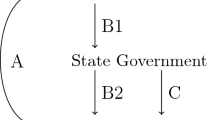Abstract
The main directions of the impact of defense expenditures on the economy have been analyzed. It has been stated that there are no clear criteria for attributing defense spending to unproductive budget expenditures. Defense expenditures have been assessed for reasonableness and sufficiency. Alternatives of the spending budget funds have been considered. Assessments of the level of Russian defense expenditures necessary for national security in the next 10 years have been given.
Similar content being viewed by others
References
A. Kudrin and I. Sokolov, “Budgetary maneuver and structural reorganization of the Russian economy,” Vopr. Ekon., No. 9, 5–27 (2017).
M. A. Bendikov and I. E. Frolov, High-Tech Industrial Sector of Russia: State, Trends, and Mechanisms of Innovative Development (Nauka, Moscow, 2007) [in Russian].
S. Acosta-Ormaechea and A. Morozumi, “Can a government enhance long-run growth by changing the composition of public expenditure?,” IMF Work. Pap., No. WP/13/162 (2013).
A. Afonso and T. Jalles, “Fiscal composition and longterm growth,” ECB Work. Pap. Ser., No. 1518 (2013).
O. Barbiero and B. Cournède, “New econometric estimates of long-term growth effects of different areas of public spending,” OECD Econ. Dep. Work. Pap., No. 1100 (2013).
J. Fournier and A. Johansson, “The effect of the size and the mix of public spending on growth and inequality,” OECD Econ. Dep. Work. Pap., No. 1344 (2016).
N. Gemmell, R. Kneller, and I. Sanz, “Does the composition of government expenditure matter for longrun GDP levels?,” Work. Pap., No. 10 (2014).
N. Baum and S. Lin, “The differential effects on economic growth of government expenditures on education, welfare, and defence,” J. Econ. Dev., No. 18, 175–185 (1993).
D. Landau, “Government and economic growth in the less developed countries: An empirical study for 1960–1980,” Econ. Dev. Cult. Change, No. 35, 34–75 (1986).
E. Hanushek and L. Woessmann, “Do better schools lead to more growth? Cognitive skills, economic outcomes, and causation,” J. Econ. Growth 17 (2012).
R. Barro, “Government spending in a simple model of endogenous growth,” J. Polit. Econ. 98 (5), 103–125 (1990).
"Defense Guarantees of Russia," Krasnaya Zvezda, June 29 (2013). http://www.redstar.ru/index.php/newspaper/item/9939-oboronnye-garant.
Structural and Investment Policy to Ensure Economic Growth in Russia: Monograph, Ed. by V. V. Ivanter (Nauchnyi konsul’tant, Moscow, 2017) [in Russian].
Dmitry Rogozin on December 28, 2017. http://www.facebook.com/dmitry.rogozin/posts/1630922253597774
The Report of the Group of Governmental Experts on the Review of the Functioning and Further Development of the United Nations Standardized Reporting Mechanism on Military Expenditures. A/66/89. United Nations. June 14, 2011.
I. E. Frolov, M. A. Bendikov, N. A. Ganichev, and O. B. Koshovets, “Analysis of the state’s financial capabilities for the development of a knowledge intensive high-tech complex of the economy for the period up to 2020,” in Forecasting the Prospects of Technological Modernization of the Russian Economy (MAKS-Press, Moscow, 2010), pp. 352–383 [in Russian].
V. I. Tsymbal, “It is necessary to adjust the plans for military construction,” Ekon. Razvit. Ross., No. 8, 49–52 (2013).
V. N. Rassadin, The Defense-Industrial Complex in the Macroeconomic Aspect (MAKS-Press, Moscow, 2013) [in Russian].
The Russian Economy in 2016. Trends and Prospects, Ed. by S. G. Sinel’nikov-Murylev and A. D. Radygin (Izd. Inst. Ekon. Polit. im. E. T. Gaidara, Moscow, 2017), Vol. 38 [in Russian]. https://iep.ru/files/text/trends/2016/Book.pdf.
The Site of the Treasury of Russia. The Operational Report of the Federal Budget of the Russian Federation. http://www.roskazna.ru/ispolnenie-byudzhetov/federalnyj-byudzhet/1021/.
The site of the Company ConsultantPlus. The Federal Law No. 362-FZ of December 5, 2017 On the Federal Budget for 2018 and for the Planning Period of 2019 and 2020. http://www.consultant.ru/document/cons_doc_LAW_284360/4f450592df3a5bf35fa3b63aedfe246940c2a560/.
“Being the third in the arms race: How much Russia spends on defense,” RBK, April 24 (2017). http://www.rbc.ru/economics/24/04/2017/58fe18c19a7947-e0ae258b18.
O. B. Koshovets and N. A. Ganichev, “Ambiguous effect of arms export on the development of the Russian high technology industry,” Stud. Russ. Econ. Dev. 26 (2), 188–197 (2015).
The Report of the Public Council under the Chairman of the Military Industrial Commission under the Government of the Russian Federation: Russia as an Importer of Arms: Challenges and Opportunities (Moscow, 2012). http://conjuncture.ru/wp-content/uploads/2012/12/report_arms-importer.pdf.
Economic and Technological Cooperation in the Context of the Eurasian Economic Space and Ukraine (CIS EDB, 2013). https://eabr.org/analytics/integration-research/ciireports/ekonomicheskaya-i-tekhnologicheskaya-kooperatsiya-v-razreze-sektorov-eep-i-ukrainy-/.
Yearbook of CAMTO-2017: Statistics and Analysis of the World Arms Trade. http://www.armstrade.org/pages/main/magazines/yearly/report/methodics/index.shtml.
A. A. Shirov, Multilevel Research and Long-Term Strategy of Economic Development (MAKS-Press, Moscow, 2015) [in Russian].
A. A. Shirov and A. A. Yantovskii, “Estimation of multiplicative effects in the economy. Possibilities and limitations,” EKO, No. 2, 40–59 (2011).
The Plan of the Ministry of Defense of Russia to Implement the Presidential Decrees of May 7, 2012 Nos. 597, 601, and 603–605. The Report for 2013. http://mil.ru/files/files/result2013/otchet2013.pdf.
The Extended Meeting of the Board of the Ministry of Defense on December 22, 2017. https://function.mil.ru/news_page/country/more.htm?id=12155960@egNews.
"Trillions have two allies, army and navy," Kommersant, Dec. 18 (2017). http://www.kommersant.ru/doc/3500710.
Author information
Authors and Affiliations
Corresponding author
Additional information
Original Russian Text © A.A. Shirov, M.S. Gusev, I.E. Frolov, 2018.
Rights and permissions
About this article
Cite this article
Shirov, A.A., Gusev, M.S. & Frolov, I.E. Macroeconomic Effects of Russian Defense Expenditures: Retrospective Analysis and Forecast. Stud. Russ. Econ. Dev. 29, 343–351 (2018). https://doi.org/10.1134/S1075700718040159
Received:
Published:
Issue Date:
DOI: https://doi.org/10.1134/S1075700718040159




